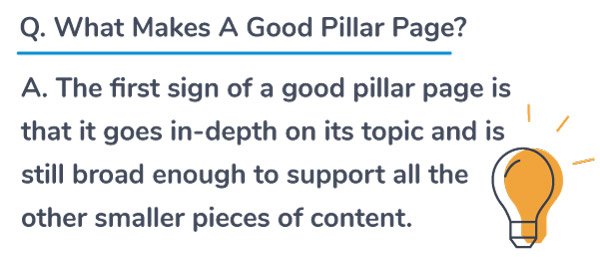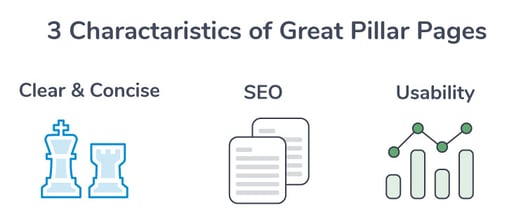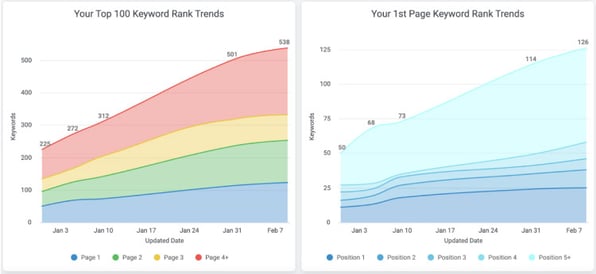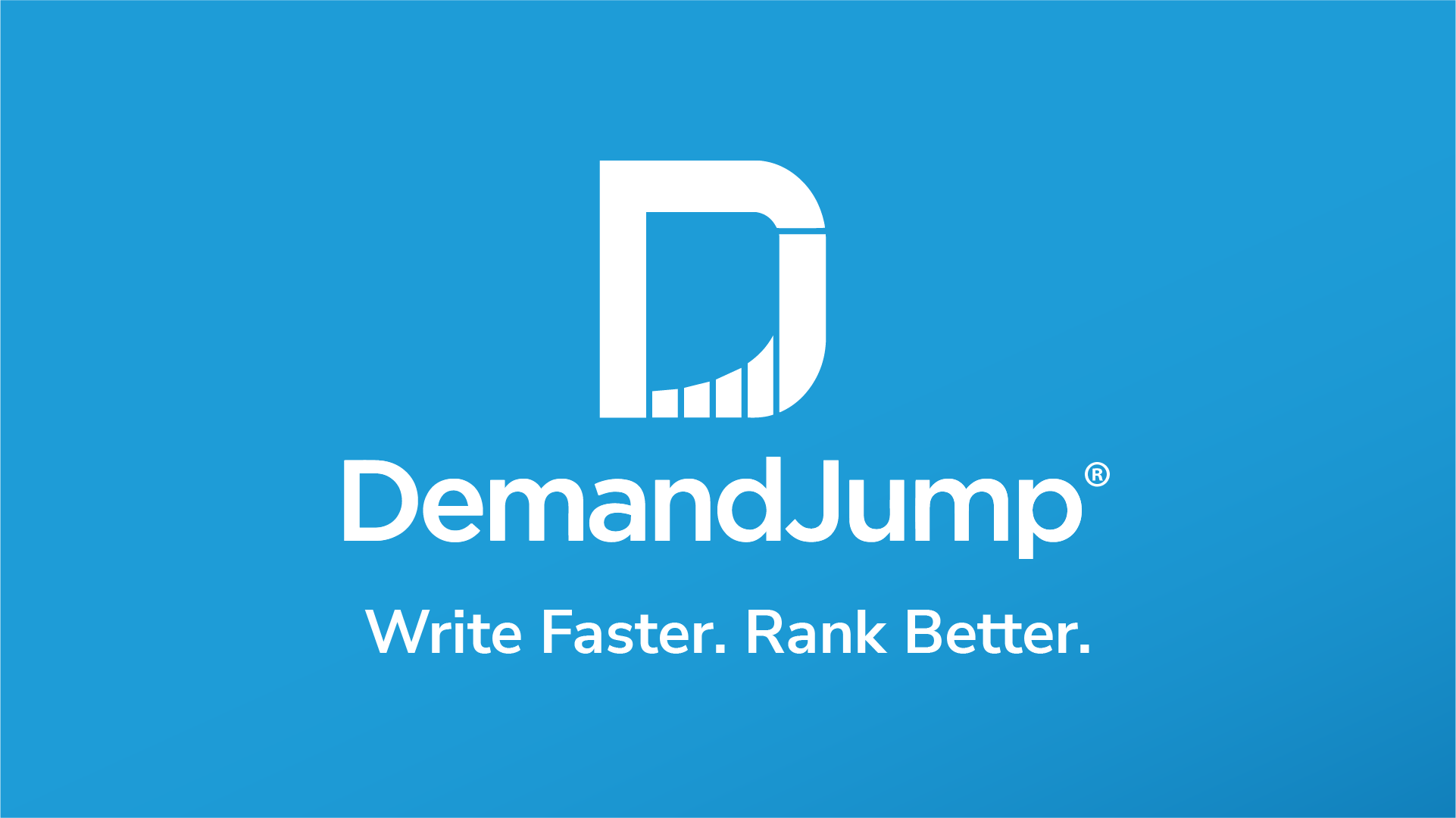Creating quality content and targeting high-value keywords are the two ingredients you need to dominate SEO, and the SEO pillar page is the blend of these two elements. So how can you effectively apply those efforts to change your ranking? Google’s search algorithm has changed over the years. Strategies used to be about stuffing as many keywords into a piece of content as possible.
Now, the algorithm has become more advanced, and it recognizes the quality of the content itself. That is why pillar pages have become an integral part of successful content marketing strategies. While the strategy is important, this blog focuses on the comprehensive individual page from which all other content in the plan is built.
What Makes A Good Pillar Page?
The first sign of a good pillar page is that it goes in-depth on its topic and is still broad enough to support all the other smaller pieces of content. If you are struggling to create blogs around your pillar page, it could be a sign that the topic of your pillar is too narrow. Regardless of your industry or topic, there are strategies anyone can use to layout a quality pillar page.
- Clear and Concise: When we say concise, we do not mean short. Pillar pages are 3000+ words. The problem is going too far off-topic. You can get to a point where you are no longer writing about the topic at hand, which can bring about the opposite results of what a pillar page is intended to do. The internet is constantly vying for the attention of each user, so the second your content is no longer relevant to what they were searching for, they will move to the following site.
- Search Engine Optimized: Even the most well-crafted pillar page will not get the best results if it is not written with targeted keywords in mind. Throughout the piece, you should be including anywhere from 10-15 keywords specific to your topic. How can you find out what your target audience is searching for? You could try guessing, but when you want accurate results, you can partner with an organization like DemandJump. DemandJump offers pillar strategy services to bolster your content marketing efforts by giving you key insights. These include a prioritized list of content to create, what your audience is searching for, and how you and your competition are performing for specific keywords.
- Usability: Your pillar page, should be easy to understand and navigate. Breaking your pillar page up into smaller sections with clearly defined headers and subheaders create a flow to the entire piece of content that is easier to digest. Including bullet points and graphics are another great way to make the information in the pillar more accessible.

What Should a Pillar Page Contain?
Your pillar page content can look wildly different from a competitor's, even if it's discussing the same topic. A pillar page could be a guide on using specific software, a tremendous resource on a subject, or a "what is" style page where you break all the information down around a topic. To better understand pillar pages, we have put together a small checklist for pillar page templates.
- A pillar page should contain at least 15-18 keywords or phrases.
- A pillar page should be skimmable. Someone may be searching for a specific answer that is in the middle of the pillar, and they need to be able to quickly locate that information.
- A pillar page should end with a call-to-action (more on this later).
- A pillar page should link to other pages on your website. This could be a product page, contact sheet, or another page with related information (does not need to be a blog or similar piece of content).
Some of you out there may be asking, "How many pages is a pillar?" For as long as they could be, should they span over multiple web pages? The pillar page is exactly how it sounds, a singular page. However, this does not mean it is the only thing on the web page. Many organizations will combine a landing page and a pillar page as the two flow together nicely. We do this ourselves.

For example, if you search for SEO keyword research and come across our page, you will notice that you are not immediately greeted with the pillar content. You will first be met with a landing page detailing some services we can provide them and an easy-to-follow step-by-step process of how we can help them. Once they begin to scroll down the page, they can find the actual pillar page content.
How do you Structure a Pillar Page?
The best way to understand what should be on a pillar page is by looking at an example of how a pillar page could look. For this example, let's use a pillar page that our team at DemandJump has created to see what a finished product could look like. Our Content Marketing pillar is a crash course on all the major elements involved in creating engaging content for a marketing campaign. The structure of this piece is a great starting point to structure your own pillar page outline, so let's dive deeper into the whole design.
Every pillar page needs to start with an attention-grabbing introduction that details what will be covered throughout the rest of the piece. The introduction can also answer a portion of the reader's question while explaining the full answer later. The benefit of answering some part of the searched question early in the piece, if possible, is that it will increase the SEO performance of the entire pillar. After the introduction, you can follow a simple layout to efficiently structure your pillar page for the reader while making it easier to write. The most effective way to outline the pillar is to break it down into sections using keywords and questions as the headers.
Speaking of headers, there is another way you can squeeze better SEO performance into the piece. The header tags (H1, H2, and H3) impact SEO performance by defining critical information. The H1 should be reserved for the title of the pillar page. All other section headers should be assigned the H2 style text, and then any subtopics important enough to get their own headers inside the H2 sections will get the H3 style text. Here are some examples of H2 headers in the content marketing pillar:
- What is content marketing?
- Why is content marketing important?
- What does a content marketer do?
- What are different types of content?
All of the sections answer different questions but relate back to the piece's title. Not everyone will Google the same question in identical ways. The goal of the pillar is to attract people on a topic even if their searches vary to some degree. If that pillar cannot directly answer their question, there should be a link to another page or piece of content that will. If you are looking for a way to ensure that all your pieces of content are answering the right questions for your audience, then partnering with DemandJump should be your next move. Once someone is brought inside your content ecosystem, you want them to stay there to find their answer.
Once the "meat and potatoes" of the pillar is complete by answering all the questions you posed and high-value keywords have been used, you can begin the call-to-action. This is the ending of the pillar page and typically where you prompt the reader to sign up for your service or encourage them to buy your product. You have just put in all the hard work explaining a subject and how there are products and services able to make their lives easier. Here is where you can quench their curious thirst. Link to your product page and express the positive impact partnering with your organization will make.
What are the Benefits of a Pillar Page?
So, you have spent all of the time and energy or spent your marketing budget on an organization like DemandJump to create this pillar content, and you want to know if it was worth it. Where is the proof of this pillar page magic? We love data, so we feel the best way to express how a pillar page can benefit your company is through concrete proof.

This is an image of the direct impact one of our clients saw after implementing a pillar page. In the first image on the left, you can see they went from ranking for around 50 keywords and now rank for over 100 keywords on the first page of Google. Looking at the second picture on the right, you can see that our client is now the first result on Google for over 25 keywords. By deploying a well-constructed pillar page (especially with DemandJump on your side), you will see rapidly increased rankings over time.
Beyond the more apparent benefits that have been discussed at length, some other benefits from a pillar page include:
- Revenue Growth: By becoming an authority on a topic and having a larger audience visit your site through the pillar page, you increase the conversion from site visitors to customers. according to WebFX, 75% of users stick to the first page of Google results. This means appearing high up on page one can result in serious business growth.
- Content Ecosystem: When someone searches a topic online, they will want to consume as much information around it as possible. Not only can the pillar page serve as this well of knowledge, but it should also provide resources to other pieces of related content.
- Faster Output: Once you start to consistently publish content using this format, it will become easier over time. Without having to guess what content to create, you will be able to cover more topics and become an authority in multiple areas, increasing business growth.
- Brand Authority: Pillar pages allow your company to be recognized by Google as an authority on a subject. This is vital to your marketing strategy efforts because a good portion of Google’s ranking algorithm relies on linking authority. So if your pillar page has the length, quality content, and supporting pages that link back to it, then your site will start to rise in the rankings as an authority.
Become a Content Authority with DemandJump
The time and thought that goes into creating any content, let alone one as comprehensive as a pillar page is extensive. Every organization does not have the staff size or resources to write its own content. That is why partnering with DemandJump takes the headaches out of content marketing. We can show you what is working for your competitors and how you compare with our market intelligence product. Try our services with a free trial today to start outranking the competition.













